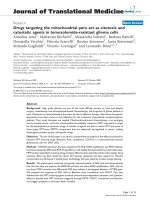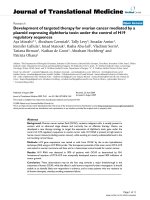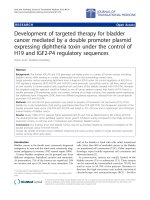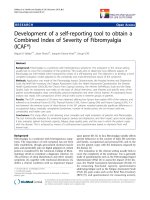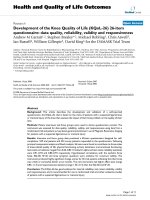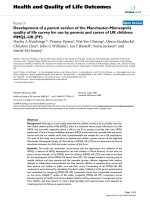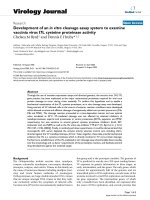báo cáo hóa học:" Development of the ATAQ-IPF: a tool to assess quality of life in IPF" doc
Bạn đang xem bản rút gọn của tài liệu. Xem và tải ngay bản đầy đủ của tài liệu tại đây (308.86 KB, 9 trang )
RESEARC H Open Access
Development of the ATAQ-IPF: a tool to assess
quality of life in IPF
Jeffrey J Swigris
1*
, Sandra R Wilson
2
, Kathy E Green
3
, David B Sprunger
1
, Kevin K Brown
1
, Frederick S Wamboldt
4
Abstract
Background: There is no disease-specific instrument to assess health-related quality of life (HRQL) in patients with
idiopathic pulmonary fibrosis (IPF).
Methods: Patients’ perspectives were collected to develop domains and items for an IPF-specific HRQL instrument.
We used item variance and Rasch analysis to construct the ATAQ-IPF (A Tool to Assess Quality of life in IPF).
Results: The ATAQ-IPF version 1 is composed of 74 items comprising 13 domains. All items fit the Rasch model.
Domains and the total instrument possess acceptable psychometric characteristics for a multidimensional
questionnaire. The pattern of correlations between ATAQ-IPF scores and physiologic variables known to be
important in IPF, along with significant differences in ATAQ -IPF scores between subjects using versus those not
using supplemental oxygen, support its validity.
Conclusions: Patient-centered and careful statistical methodologies were used to construct the ATAQ-IPF version
1, an IPF-specific HRQL instrument. Simple summation scoring is used to derive individual domain scores as well as
a total score. Results support the validity of the ATAQ-IPF, and future studies will build on that validity.
Introduction
Patient reported outcomes (PRO), such as quality of life
(QOL) or health-related QOL (HRQL), are commonly
used endpoints in clinic al studies and therapeutic trials
in patients with pulmonary diseases. Instruments that
assess PRO focus on the perceptions of patients with
the condition of interest; as such, they generate mean-
ingful data on disease effects not captured by other out-
come measures.
HRQL instruments are generic or disease-specific. The
merit of disease-specific instruments is that they contain
only items pertinent to patients with the disease of
interest. Because of this, disease-specific instruments
tend to be more responsive than generic instruments to
underlying change. Disease-specific HRQL instruments
have been develo ped for a number of p ulmonary condi-
tions, including chronic obstructive pulmonary disease
[1-3] and asthma,[4,5] but not for i diopathic pulmonary
fibrosis (IPF).
IPF is a progressive, fibrosing, parenchymal lung dis-
ease[6] with distinctive pathophysiological processes. IPF
has no reliably effective therapy, a nd survival rates are
worse than for many cancers [7]. In people with IPF,
dyspnea limits physical activity, and hypoxemia ulti-
mately develops, requiring patients to use supplemental
oxygen. Given these discomforting aspects and the poor
survival rates, it is not surprising that generic HRQL in
patients with IPF is impaired [8,9]. Because IPF lacks a
cure, there is a great deal of interest in maintaining or
improving HRQL, so patients can live with acceptable
QOL for however long they survive. Without a disease-
specific instrument, there will continue to be uncertainty
regarding whether relevant aspects and effects of the
disease are being measured adequately and whether
drug therapies, or other interventions, have a net benefi-
cial or adverse impact on HRQL. In this manuscript, we
report on the development an IPF-specific HRQL
instrument called the ATAQ-IPF (A Tool to Assess
QOL in IPF) version 1.
Methods
Questionnaire Development
Phase I: Item Development
Development of the ATAQ-IPF began with the con-
duct of three focus groups and five in-depth interviews
* Correspondence:
1
Autoimmune Lung Center and Interstitial Lung Disease Program, National
Jewish Health, 1400 Jackson Street, Denver, Colorado, 80206, USA
Swigris et al. Health and Quality of Life Outcomes 2010, 8:77
/>© 2010 Swigris et al; licensee BioMed Central Ltd. This is an Open Access article distributed under the terms of the Crea tive Common s
Attribution License ( 2.0), which permits unrestricted use, distribut ion, and reproduction in
any medium, provided the original work is properly cited.
with individual IPF patients, through which we concep-
tualized a framework for describing HRQL in IPF.
Details of this step were reported previously [10]. We
used themes and whenever possible, exact phrases spo-
ken by focus group members or interviewees to
develop d omains and a pool of over 200 total items. In
two additional focus groups, each with eight IPF
patients, we reviewed domains (derived from themes)
and items to ensure appropriate wording and coverage
and to make revisions if necessary. Reordering
and renaming of the original 12 yielded 14 domains:
Cough, Dyspnea, Forethought, Sleep, Mortality,
Exhaustion, Emotional Well-being, Spirituality, Social
Participation, Finances, Independence, Sexual Health,
Relationships, and Therapies.Atthisstage,thepool
consisted of 207 items. All items employed a five-point
Likert response format.
Phase II: Domain and Response Category Refinement and
Item Reduction
Next, we enrolled 95 s ubjects with IPF (89 from the
Interstitial Lung Disease (ILD) clinic at National Jewish
Health and 6 from the I LD clinic at the University of
Pennsylvania) who responded to the 207-item po ol. IPF
was diagnosed by multi-disciplinary consensus, accord-
ing to internationally accepted guidelines [6]. We
sequentially applied a selection criterion (based on
response variance) and Rasch analysis to pare down
items. First, items were retained if the sum of the pro-
portion of respondents affirming response options (1)
“Strongly disagree” or (2) “Disagree somewhat” was ≥
25% and options (4) “Agree somewhat” or (5) “Strongly
agree” was ≥ 25% (i.e., 1 + 2 ≥ 25% and 4 + 5 ≥ 25%);
other items were eliminated.
Next, separate Rasch analyses[11] we re performed on
clusters of retained items within each of the 14 indivi-
dual domains and then on the resultant item pool in
its entirety after item elimination at the domain level.
In Rasch analysis, a mathematical model is generated
to describe the relationship between respondents and
the items that operationalize a construct (o r trait). For
our purposes, for the analyses performed on the indivi-
dual domains, the constructs are implied by the
domain names (e.g., cough, dyspnea, exhaustion, etc.),
and for the analysis of the entire item pool after item
elimination, the over-arching construct is impairment
in HRQL.
The Rasch model generates two estimates, called
person location (or logit) and item location (or logit),
which are nonlinear (log odds) transformations of raw
scores. The likelihood of higher scores (i.e., person
logit) increases as patients have more of the trait; thus,
for our purposes, respondents with higher scores have
greater impairments in the constructs tapped by the
individual domains or in global HRQL. By placi ng per-
son and item logits along opposite sides of a vertical
line, in what is calle d an item map, Rasch analysis
reveals how well i tems target t he population under
study. For dichotomous items (not the case for the
ATAQ-IPF), when person and i tem logits are equal
(i.e., directly across from each other on the item map),
the person has a 50% probability of affirming the item.
A r espondent with more of a trait–thus, greater person
logit–would b e expected to affirm any item with a logit
less than his person logit. For polytomous items, like
those from the ATAQ-IPF, the analysis generates logit
positions at the transitions between any adjacent
response options (e.g., where the likelihood of
responding “Strongly agree” is greater than t he likeli-
hood of responding to the adjacent option “ Agree
somewhat” and so-on). If requirements of the Rasch
model are met, the scale (here, this holds for the indi-
vidual domains and for the instrument in its entirety)
will have addit ive measurement properties, or “behave
likearuler” [12].
There are no absolute criteria, but perhaps the most
commonly used measure of item fit to the Rasch
model–andtheoneweemployed–is the infit mean
square statistic. We identified items that both fit the
Rasch model (infit mean square statistic 0.5-1.5 is con-
sidered useful for measurement[13]) and adequately cov-
ered the range of person locations according to the item
map. Because having mult iple items at the same logit
position does not substantially add to a questionnaire’s
capacity to distinguish respondents with differing levels
of the trait under study, we deleted excess items clus-
tered at the same logit position. In sum, for paring
down items, we followed these steps: 1) examination of
item response variance and deletion of items that did
not meet the criterion; 2) Rasch analysis on clusters of
items within each domain and deletion of poor-f itting
or redundant i tems; and 3) Rasch analysis of all retained
items to ensure fit to the Rasch model and to generate
statistics for the instrument as a whole.
Psychometric Testing of ATAQ-IPF items
We used Pearson correlation coefficients to examine
associations between domain scores and between
scores for each domain and all other items in aggre-
gate (exclusive of the domain under study). We
assessed internal consistency reliability of each domain
and the entire instrumen t with Cronbach’s coefficient
alpha [14]. Experts suggest alpha sh ould be 0.7-0.9 for
subscales of a multi-dimensional questionnaire,[15]
with goal values of 0.9 for individual placement and ≥
0.7 for research purposes [16]. Rasch model reliability
was assessed by using the reliability of the person
Swigris et al. Health and Quality of Life Outcomes 2010, 8:77
/>Page 2 of 9
separation index, similar in its interpretation to Cron-
bach’s coefficient alpha.
ATAQ-IPF scores and their associations with clinical
measures
Simple summation scoring is used to produce domain
scores and a total score (range 74-370). Higher scores
correspond to greater impairment.
On the day the questionnaire was completed, each
subject performed pulmonary function tests (PFT) and a
six-minute walk test (6MWT). PFT were performed
according to American Thoracic Society standards, and
results are repo rted as percentages of the predicted
values (e.g., FVC% or DLCO%) [17,18]. The 6MWT was
conducted as described previously, and distance walked
(6MWD) was recorded [19]. Variables were tested for
normality by using the Shapiro-Wilk test. Pearson (for
normally distributed variable s) or Spearman (for non-
normally distributed variables) correlation was used to
test the null hypothesis of no association between FVC
%, DLCO%, or 6MWD and ATAQ-IPF domain and
total scores. We also used multivariable linear regression
to examine the relationship between the ATAQ-IPF
total score and both FVC% and DLCO%. We used t
tests (for normally distributed variables) or the Wil-
coxon rank-sum test (for non-normally distributed vari-
ables) to compare mean ATAQ-IPF scores between
subjects using versus not using suppleme ntal oxygen.
We hypothes ized scores would be higher (more impair-
ment in HRQL) for subjects requiring supplemental
oxygen.
Statistical Issues
Winsteps version 3.69.1.14 was
used to perform the Rasch analyses. SAS version 9.2 (SAS,
Inc.; Cary, NC) was used to run all other statistics. We
considered p < 0.05 as statistically significant. This project
complied with the Helsinki Decla ration. Each subject
signed an informed consent, and the study protocol was
approved by the Institutional Review Boards of the Uni-
versity of Pennsylvania and National Jewish Health.
Results
Baseline characteristics
Table 1 displays baseline demographic and disease para-
meters (including ATAQ-IPF scores) for the study sam-
ple. The mean time from diagnosis to questionnaire
completion was 2.9 years. Just over 60% of the sample
used supplemental oxygen, a nd mean physiology values
suggested moderately severe IPF.
Table 1 Baseline Characteristics of Subjects
Male, % 82
Ethnicity, %
Caucasian 94
Black 1
Other 5
Age yrs 69.3 (7.6)
Smoking status, %
Past 64
Never 36
Had surgical biopsy, % 56
Time since diagnosis, yrs 2.9 (2.8)
Using supplemental O2, %
Not at all 39
Exertion and sleep 31
Continuous 30
FVC% 65 (17)
DLCO% 39 (15)
6MWD, feet 1147 (441)
Taking IPF medications, %
Prednisone 24
Azathioprine 14
N-acetyl cysteine 24
Carries a diagnosis of ___, %
Emphysema (by HRCT) 15
PH by echocardiogram 31
Stable CAD 24
ATAQ-IPF scores:
Raw T
Cough 16 (7)
Dyspnea 19 (6)
Forethought 14 (6)
Sleep 16 (5)
Mortality 17 (5)
Exhaustion 15 (5)
Emotional Well-Being 20 (6)
Social Participation 15 (5)
Finances 17 (7)
Independence 14 (5)
Sexual Health 15 (6)
Relationships 17 (4)
Swigris et al. Health and Quality of Life Outcomes 2010, 8:77
/>Page 3 of 9
Item reduction
After the final two focus groups, the questionnaire had
207 items. On average, 40 minutes were required to
respond to those items. Afte r implementing the selec-
tion criterion based on item variance, 91 items were
dropped, leaving 125 items for the Rasch ana lyses (Fig-
ure 1). The Finances, Sexual Health, Relationships, and
Therapies domains were left with fewer than six items
after the selection criterion. To perform a robust Rasch
analysis on each of these domains, we includ ed all their
candidate items, even though some did not meet the
variance criterion. An example of an item map for the
Independence domain is displayed in Figure 2.
Domain-total correlations were statistically significant
for every domain except Therapies. On balance, internal
consist ency reliability of the domains and overall instru-
ment was excellent, and Rasch model reliability of per-
son separation was good (Table 2). All retained items fit
the Rasch model. Because o f poor fitting it ems, the
Spirituality domain and its items were dropp ed from the
questionnaire, leaving 1 3domainsfortheATAQ-IPF
version 1.
Correlations with lung function and functional status
We observed significant correlations betw een measures
of pulmonary physiology or functional capacity and
ATAQ-IPF domain or total scores (Table 3). FVC%
and DLCO% were significantly correlated with eight
and nine respectively of the 13 ATAQ-IPF domain
scores evaluated, as well as with the ATAQ-IPF total
score. The 6MWD was significantly correlated with
five domain scores as well as the ATAQ-IPF total. In a
linear regression model of the ATAQ-IPF total score
that included FVC% and DLCO% as predictors, FVC%
Cough Dyspnea Forethought Sleep Mortality Exhaustion Emotional
24 24 8 8 22 18 Well-being
37
37
Spirituality Social Finances Independence Sexual Relationships Therapies
5 Participation 6 11 Health 13 12
631
Items = 207
Apply item variance criterion
Cou
g
h Dyspnea Forethoug
ht Slee
p Mortality Exhaustion Emotional
g
yp g p y
17 12 8 6 7 13 Well-being
19
Spirituality Social Finances Independence Sexual Relationships Therapies
5 Participation 5 8 Health 6 6
94
Items = 125
94
Rasch analysis
Cough Dyspnea Forethought Sleep Mortality Exhaustion Emotional
6 6 5 6 6 5 Well-being
7
Social Finances Independence Sexual Relationships Therapies
Items = 74
Social Finances
Independence
Sexual Relationships
Therapies
Participation 6 5 Health 6 6
55
Figure 1 Sequence of item reduction.
Table 1 Baseline Characteristics of Subjects (Continued)
Therapies 16 (4)
Total 210 (46)
Data presented as % or mean (standard deviation); O2 = oxygen; FVC% =
percent predicted forced vital capacity; DLCO% = percent predicted diffusing
capacity of the lung for carbon monoxide; COPD = chronic obstructive
pulmonary disease; HRCT = high-resolution computed tomography scan; PH =
pulmonary hypertension; CAD = coronary artery disease
Swigris et al. Health and Quality of Life Outcomes 2010, 8:77
/>Page 4 of 9
g
pp
LOGIT SCALE PERSONS ITEMS
Less Independent More difficult to agree with
(i.e., more difficult to respond Strongly Agree)
2
+
|
|
|
|
|
|
|
| Give up control(4-5)
|
|
|
|
| Feel like burden(4-5)
| Rearrange(4-5)
X |
1 + Frustrated(4-5)
|
|
|
X T| Ask for help(4-5)
X |
|
XXX |T Give up control(3-4)
|
XXX |
XXX |
XXXXXXX S
|S|
XXXXXX |
X | Rearrange(3-4)
Feel like burden(3-4)
XXXX | Give up control(2-3)
0 XXXXX +M
XXXXXX | Frustrated(3-4)
XXXXXXX |
XXXXXXXXXX M|
XXX |S Rearrange(2-3) Ask for help(3-4)
Feel like burden(2-3)
XXXX |XXXX |
XXXXXX | Give up control(1-2)
XXXX | Frustrated(2-3)
|T
XXXX |
XX S|
X | Ask for help(2-3)
XX | Rearrange(1-2)
Feel like burden(1-2)
XXXXXX |
|
-1 XX + Frustrated(1
-2
)
|
X T|
| Ask for help(1-2)
|
X |
|
|
|
|
X ||
|
|
|
|
-2 +
PERSONS ITEMS
More Independent Easier to agree with
(i.e., easier to respond Strongly Agree)
Figure 2 Item map for Independence domain. X = one subject; M = mean; S = one standard deviation from mean; T = two s tandard
deviations from mean. The item positions for the five items in the independence domain appear on the right of the vertical dashed line. The
person positions appear on the left of the line. Recall the five response options: (1)"Strongly disagree” (2)"Disagree somewhat” (3)"Neither
disagree nor agree” (4)"Agree somewhat” and (5)"Strongly agree.” Each item appears four times at logit positions that mark transitions between
adjacent response options. The numbers in parentheses connote the adjacent response options. Thus, consider “Ask for help(1-2)” at the lowest
(easiest) location on the map: this is the location where the likelihood that a subject would respond (2)"Disagree somewhat” to this item
becomes greater than the likelihood he would respond (1)"Strongly disagree” to this item. The most difficult item from this domain (located at
the top of the map) is “Give up control.” The map is designed such that mean item location (difficulty) is at 0 logits (notice the “M” on the right
side of the vertical line). Mean person location (ability, indicated by the “M” on the left side of the vertical line) is lower on the vertical line (i.e.,
fewer logits) than the mean item difficulty, thus indicating that item difficulty is slightly greater than person ability.
Swigris et al. Health and Quality of Life Outcomes 2010, 8:77
/>Page 5 of 9
(estimate = -0.09, p = 0.78) was not an independent
predictor of the ATAQ-IPF total; DLCO% was (esti-
mate = - 1.57, p < 0.000 1). The R-square value for this
model was 0.25.
Differences in ATAQ-IPF scores between subjects not
using vs. those using supplemental oxygen
Nine domain scores (including Dyspnea and Exhaustion)
and the ATAQ-IPF total score were significantly greater
for subjects who required supplemental oxygen than for
subjects who did not use supplemental oxygen (Table 4).
Discussion
We have developed the ATAQ-IPF version 1, an IPF-
specific HRQL questionnaire. We used direct patient
inquiry to generate an item pool, and we used rigorous
statistical methods to reduce item numbers and con-
struct an instrument that contains items tapping
domains specifically relevant to patients with IPF.
In Phase I of item reduction, we deleted items with
skewed response distributions–this serves the goal of
maximizing the power of the ATAQ-IPF to discriminate
between respondents with diff erent degrees of HRQL
impairment–and reduced item numbers by nearly half.
We subjected the remaining items (in their domains and
in aggregate) to Rasch analysis. The retained items–by
virtue of fitting the Rasch model, like all items that fit
the Rasch model–are guaranteed to have the sa me mea-
surement characteristics as concrete physical measures
(e.g., length or weight). Thus, b y incorporating Rasch
analysis into the development of the ATAQ-IPF, unlike
other HRQL questionnaires for which Rasch methodol-
ogy was not used, we can be confident that it adheres to
the basic tenet of arithmetic: ‘one more unit means the
same amount extra, no matter how much we already
have’ [20]. So, an increase of one point for an ATAQ-
IPF domain or total score means the same thing
whether a respondent has severely impaired or near-
normal HRQL. This linearit y that the Rasch model con-
structs differs from the assumed linearity of classical test
theory and much of item response theory–methodolo-
gies used to develop the majority of HRQL instruments
[21].
By running Rasch analyses on clusters of items formu-
lating each domain, we were able to pare down items in
a systematic fashion. By dropping poor-fitting items, or
certain ones fro m groups with identical logit positions
(that only serve to make the questionnaire longer and
not necessarily enhance t he ATAQ-IPF’spowertodis-
criminate between respondents whose status changes
Table 2 Results of psychometric and Rasch analyses for the domains of the ATAQ-IPF
Domain Items (N) Domain-Total Correlation
(p value)
Internal Consistency Reliability* Rasch Model Reliability
Cough 6 0.38
(0.0002)
0.92 0.83
Dyspnea 6 0.71
(<0.0001)
0.87 0.83
Forethought 5 0.67
(<0.0001)
0.89 0.82
Sleep 6 0.46
(<0.0001)
0.67 0.71
Mortality 6 0.42
(<0.0001)
0.74 0.78
Exhaustion 5 0.72
(<0.0001)
0.79 0.8
Emotional Well-being 7 0.68
(<0.0001)
0.85 0.82
Social Participation 5 0.65
(<0.0001)
0.81 0.78
Finances 6 0.49
(<0.0001)
0.9 0.67
Independence 5 0.72
(<0.0001)
0.81 0.74
Sexual Health 5 0.48
(<0.0001)
0.81 0.74
Relationships 6 0.6
(<0.0001)
0.61 0.71
Therapies 6 0.19
(0.07)
0.74 0.51
Total 74 - 0.94 0.93
*Cronbach’s coefficient alpha
Swigris et al. Health and Quality of Life Outcomes 2010, 8:77
/>Page 6 of 9
over time), we were able to shorten the length of each
domain.
The detailed and carefully executed item reduction
techniques we used have not been implemented in the
development of many other HRQL instruments. Generat-
ing content for the ATAQ-IPF, by directly capturing
patients’ perspectives and using them to build the frame-
work (and specific items) of the questionn aire, ensu re its
content validity. Involving IPF patients in the develop-
ment process ensures that all relevant themes and effects
are tapped. It is the incorporation of such perspectives
that makes the ATAQ-IPF uniquely applicable to IPF
patients and not necessarily to patients with other forms
of lung disease. Further, including only items that fit the
Rasch model guarantees each of the ATAQ-IPF’s scales
(domain and total) maintain their additive properties. To
our knowledge, only one other inve stigato r has used this
type of approach in the development of respiratory d is-
ease-specific HRQL instruments [2,3].
Psychometric testing revealed that domains and the
overall instrument possess excellent internal consistency
reliability [16] . Domain-total correlations confirmed that
each domain measures some aspect of the same under-
lying construct–HRQL–and that each contributes infor-
mation about HRQL unique from the aggregate
contribution of the other items. The ATAQ-IPF, then,
functio ns like an arithmetic test that has individual sec-
tions that assess addition, subtraction, multiplication,
and division: the test score portrays overall arithmetic
ability but the sections can point to areas in which a
student might excel or need additional instruction. Like-
wise,theATAQ-IPFoverallscoresservesasameasure
of global HRQL, and the domain scores can be used to
examine more closely the nature o f the impact of an
intervention on HRQL.
The significant correlations between domain scores
and FVC%, DLCO%, and 6MWD showed that ATAQ-
IPF sco res are related to –but also y ield their own
unique information from–clinically meaningful, com-
monly used measures of IPF severity. Results from the
linear regression analysis add more weight: in a model
that controlled for arguably the two most important
physiolog ic measures used to assess IPF patients (FVC%
and DLCO%), those measures combined to explain only
25% of the variability (R-square = 0.25) in the ATAQ-
IPF total score. Thus, there are factors not captured by
these physiologic measures that contribute to HRQL in
patients with IPF. Interestingly, th ere was moderately
strong correlation between DLCO% and the Social Parti-
cipation, Ind ependence, and Sexual Health domains, and
there were significant correlations between 6MWD and
these domains as well as with the Relationships domain.
These results indicate that gas exchange and functional
capacity influence more than simply physical well-being,
and they underscore the importance of extending HRQL
measures to include such domains in patients with IPF.
Investigators commonly view significant associations
between HRQL scores and clinical measures of disease
severity or functional status as evidence for the validity
of an instrument; however, the importance of such
associations is primarily in understanding which mani-
festations of a disease have the greatest effects on
HRQL–they are much less relevant to validity. So,
although such correlations in this study confirmed our
hypotheses that HRQL would be related to IPF severity
(as measured by these physiologic variables), the validity
oftheATAQ-IPF(oranyotherinstrument)isbest
judged over time on three other terms: 1) its content–
whether it covers all the relevant dimensions on which
individuals evaluate their HRQL, or at least those that
might be affected by the disease in question; 2) whether
items require respondents to indicate the extent to
which their QOL (on the various domains) is compro-
mised by their disease; and 3) whether resulting scores
are reliable, sensitive, and responsive to change. The
ATAQ-IPF certainly meets terms 1 and 2, and further
Table 3 Correlations between pulmonary function or six-
minute walk distance and ATAQ-IPF scores
Domain FVC% DLCO% 6MWD
Cough -0.26
p = 0.01
-0.19
p = 0.08
-0.004
p = 0.98
Dyspnea -0.40
p < 0.0001
-0.52
p < 0.0001
-0.23
p = 0.09
Forethought -0.37
p = 0.0003
-0.58
p < 0.0001
-0.35
p = 0.009
Sleep -0.18
p = 0.07
-0.1
p = 0.38
-0.18
p = 0.18
Mortality 0.14
p = 0.19
-0.05
p = 0.65
0.05
p = 0.73
Exhaustion -0.33
p = 0.001
-0.46
p < 0.0001
-0.16
p = 0.26
Emotional Well-being -0.19
p = 0.06
-0.32
p = 0.003
-0.18
p = 0.17
Social Participation -0.21
p = 0.04
-0.51
p < 0.0001
-0.33
p = 0.01
Finances -0.001
p = 0.98
-0.18
p = 0.12
-0.08
p = 0.58
Independence -0.32
p = 0.0015
-0.47
p < 0.0001
-0.39
p = 0.004
Sexual Health -0.20
p = 0.04
-0.55
p < 0.0001
-0.41
p = 0.002
Relationships -0.28
p = 0.006
-0.40
p = 0.0002
-0.40
p = 0.003
Therapies 0.07
p = 0.48
0.21
p = 0.05
0.29
p = 0.03
ATAQ Total -0.29
p = 0.006
-0.52
p < 0.0001
-0.28
p = 0.04
FVC% = percentage of predicted value for forced vital capacity;
DLCO%= percentage of predicted value for diffusing capacity of the lung for
carbon monoxide; 6MWD = total distance walked during six-minute timed
walk test; N = 95 for FVC, 82 for DLCO, and 54 for 6MWD
Swigris et al. Health and Quality of Life Outcomes 2010, 8:77
/>Page 7 of 9
investigation will determine term 3. As with any HRQL
questionnaire, validity is not achieved (or even deter-
mined) in a single study–it is built. It is only through
observing the performance of a questionnaire in multi-
ple studies over time that we can confidently say that it
measures what it was intended to measure. That said,
the results of the analysis in which we examined differ-
ences in ATAQ-IPF scores betw een subjects not using
and those using supplemental oxygen support the valid-
ity of the ATAQ-IPF: subjects using supplemental
oxygen had more dyspnea and exhaustion, less i ndepen-
dence, required more forethought, and had greater
impairments in emotional well-being, social participa-
tion, sexual health, relationships, and overall HRQL
(according to the ATAQ-IPF total) than subjects not
using supplemental oxygen.
Although 74 items comprise version 1 of the ATAQ-
IPF, this number of items enables it to tap myriad
important constructs and to report scores at the domain
level. Whether item number c an be reduced further,
without unacceptable loss of content or reliability,
requires additional investigation. Moving forward, we
will use the ATAQ-IPF as a secondary outcome measure
in a longitudinal study, and we invite other investigators
to use the ATAQ-IPF version 1 in their studies as well.
Conclusion
In sum, we have developed an IPF-specific instrument
to measure HRQL. We used patients’ views to generate
themes and items and then systematically implemented
statistical techniques to pare down item number. Items
fit the Rasch model, and internal consistency supported
reporting of domain and total scores. In future studies,
data will be gathered to help further support the
ATAQ-IPF’s validity in IPF and to determine if it might
be useful in other forms of interstitial lung disease.
Acknowledgements
The authors wish to thank and acknowledge Michael Gould, MD, MS; Susan
Jacobs, RN, MS; Michael Linacre, PhD; Milton Rossman, MD; Anita Stewart,
PhD; David Streiner, PhD; and Janelle Yorke, PhD for their assistance and
thoughtful input at various stages of this project.
Author details
1
Autoimmune Lung Center and Interstitial Lung Disease Program, National
Jewish Health, 1400 Jackson Street, Denver, Colorado, 80206, USA.
2
Palo Alto
Medical Foundation Research Institute, Palo Alto Medical Foundation, 795 El
Camino Real, Palo Alto, California, 94301, USA.
3
Morgridge College of
Education, University of Denver, 2199 S University Blvd, Denver, Colorado,
80210, USA.
4
Division of Psychosocial Medicine, National Jewish Health, 1400
Jackson Street, Denver, Colorado, 80206, USA.
Authors’ contributions
Study conceptualization: JJS, SW. Data collection: JJS, DS, KB. Data analysis:
JJS, SW, KG, FW. Writing and final approval of manuscript: JJS, SW, KG, DS,
KB, FW.
Competing interests
JJS is supported in part by a Career Development Award from the NIH (K23
HL092227). The authors declare that they have no competing interests
Received: 30 April 2010 Accepted: 31 July 2010 Published: 31 July 2010
References
1. Guyatt G, Walter S, Norman G: Measuring change over time: assessing the
usefulness of evaluative instruments. J Chronic Dis 1987, 40:171-178.
2. Jones PW, Harding G, Berry P, Wiklund I, Chen WH, Kline Leidy N:
Development and first validation of the COPD Assessment Test. Eur
Respir J 2009, 34:648-654.
3. Meguro M, Barley EA, Spencer S, Jones PW: Development and Validation
of an Improved, COPD-Specific Version of the St. George Respiratory
Questionnaire. Chest 2007, 132:456-463.
4. Juniper EF, O’Byrne PM, Guyatt GH, Ferrie PJ, King DR: Development and
validation of a questionnaire to measure asthma control. Eur Respir J
1999, 14:902-907.
5. Hyland ME, Finnis S, Irvine SH: A scale for assessing quality of life in adult
asthma sufferers. J Psychosom Res 1991, 35:99-110.
Table 4 Comparison of ATAQ-IPF scores between subjects using vs. not using supplemental oxygen
Domain Not using supplemental O2
N=37
Using supplemental O2
N=58
P value
Cough 15.9 (7.5) 16.2 (7.3) 0.6
Dyspnea 16.8 (6.6) 20.8 (6.0) 0.003
Forethought 10.9 (5.5) 16.2 (5.3) <0.0001
Sleep 15.4 (4.6) 16.5 (4.7) 0.3
Mortality 16.8 (4.5) 17.4 (5.3) 0.6
Exhaustion 12.9 (4.6) 16.1 (4.5) 0.002
Emotional Well-being 18.0 (5.5) 21.1 (6.6) 0.01
Social Participation 11.7 (4.4) 16.3 (5.0) <0.0001
Finances 16.3 (7.1) 17.4 (6.3) 0.4
Independence 11.6 (4.8) 15.8 (5.2) 0.0005
Sexual Health 12.7 (7.3) 16.3 (4.6) 0.0008
Relationships 15.2 (4.0) 18.3 (4.3) 0.0007
Therapies 16.9 (4.2) 15.1 (3.7) 0.04
ATAQ Total 191.0 (45.8) 223.1 (43.7) 0.001
Swigris et al. Health and Quality of Life Outcomes 2010, 8:77
/>Page 8 of 9
6. American Thoracic Society: Idiopathic pulmonary fibrosis: diagnosis and
treatment. International consensus statement. American Thoracic Society
(ATS), and the European Respiratory Society (ERS). Am J Respir Crit Care
Med 2000, 161:646-664.
7. Olson AL, Swigris JJ, Lezotte DC, Norris JM, Wilson CG, Brown KK: Mortality
from pulmonary fibrosis increased in the United States from 1992 to
2003. Am J Respir Crit Care Med 2007, 176:277-284.
8. Swigris JJ, Gould MK, Wilson SR: Health-related quality of life among
patients with idiopathic pulmonary fibrosis. Chest 2005, 127:284-294.
9. Swigris JJ, Kuschner WG, Jacobs SS, Wilson SR, Gould MK: Health-related
quality of life in patients with idiopathic pulmonary fibrosis: a
systematic review. Thorax 2005, 60:588-594.
10. Swigris JJ, Stewart AL, Gould MK, Wilson SR: Patients’ perspectives on how
idiopathic pulmonary fibrosis affects the quality of their lives. Health
Qual Life Outcomes 2005, 3:61.
11. Rasch G: Probabilistic models for some intelligence and attainment tests.
Danish Institute of Educational Research 1960.
12. Bond T, Fox C: Applying the Rasch Model: Fundamental Measurement in the
Human Sciences Mahway, New Jersey: Lawrence Erlbaum Associates 2007.
13. Linacre J: What do Infit and Outfit, Mean-square and Standardized
mean? Rasch Measurement Transactions 2002, 16:878.
14. Cronbach L: Coefficient alpha and the internal structure of tests.
Psychometrika 1951, 22:293-296.
15. Streiner D, Norman G: Health Measurement Scales: A practical guide to their
development and use New York: Oxford University Press, Fourth 2008.
16. Nunnally J: Psychometric Theory New York: McGraw-Hill 1978.
17. American Thoracic Society: Lung function testing: selection of reference
values and interpretative strategies. Am Rev Respir Dis 1991,
144:1202-1218.
18. American Thoracic Society: Standardization of spirometry, 1994 update.
Am J Respir Crit Care Med 1995, 152:1107-1136.
19. Swigris JJ, Swick J, Wamboldt FS, et al: Heart Rate Recovery After 6-Minute
Walk Test Predicts Survival in Patients With Idiopathic Pulmonary
Fibrosis. Chest 2009, 136:841-848.
20. Linacre J: Measurement, Meaning and Mortality. Pacific Rim Objective
Measurement Symposium and International Symposium on Measurement and
Evaluation. Kuala Lumpur, Malaysia 2005.
21. Linacre JM: Lesson 1. Pracitcal Rasch Measurement - Core Topics 2010 [http://
www.statistics.com].
doi:10.1186/1477-7525-8-77
Cite this article as: Swigris et al.: Development of the ATAQ-IPF: a tool
to assess quality of life in IPF. Health and Quality of Life Outcomes 2010
8:77.
Submit your next manuscript to BioMed Central
and take full advantage of:
• Convenient online submission
• Thorough peer review
• No space constraints or color figure charges
• Immediate publication on acceptance
• Inclusion in PubMed, CAS, Scopus and Google Scholar
• Research which is freely available for redistribution
Submit your manuscript at
www.biomedcentral.com/submit
Swigris et al. Health and Quality of Life Outcomes 2010, 8:77
/>Page 9 of 9
